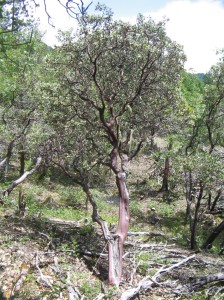 Manzanita trees and shrubs are native to western North America. They are known for their orange to red smooth bark, and the unique and sometimes twisted shapes that they grow into. According to Wikipedia, there are 106 known species of manzanita. These can range from small, low growing ground covers, to small trees that can grow up to as high as 20 feet.
Manzanita trees and shrubs are native to western North America. They are known for their orange to red smooth bark, and the unique and sometimes twisted shapes that they grow into. According to Wikipedia, there are 106 known species of manzanita. These can range from small, low growing ground covers, to small trees that can grow up to as high as 20 feet.
Where to get manzanita plants.
Whiteleaf manzanita, Arctostaphylos viscida Is one of the most common and the largest species. This is the variety that is commonly used for decorative manzanita branches and other wood products. Whiteleaf manzanita grows naturally in dry to semi dry Mediterranean types of climates, ranging from Mexico, through California, Arizona, Nevada, Oregon, and Washington. (not sure if they are native to Washington)
Manzanita Blossoms
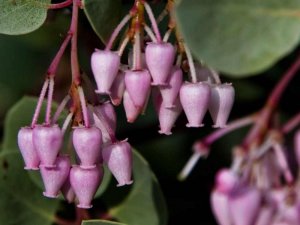 Around the turn of spring, manzanita produces small bell shaped blossoms that can range from white to pink. Blooming manzanita will be surrounded by the fragrance of honey, and will usually be alive with the sound of bees and hummingbirds, feasting on the blossom’s sweet and fragrant nectar.
Around the turn of spring, manzanita produces small bell shaped blossoms that can range from white to pink. Blooming manzanita will be surrounded by the fragrance of honey, and will usually be alive with the sound of bees and hummingbirds, feasting on the blossom’s sweet and fragrant nectar.
You don’t have to be a bee or a hummingbird to enjoy manzanita nectar. If you carefully squeeze a blossom, starting from the stem end, a drop of honey tasting nectar will be pushed out the open end. It’s a must do treat when in the vicinity of blooming manzanita. But watch out for bees, although most of them are too busy gathering nectar to want to sting.
Manzanita Berries
 After the blossoms drop, small green berries start to grow, which become red as they ripen in the summer. The shape of the berries (which are usually around 1/4 inch) resemble miniature apples, which is where manzanita gets its name. Manzanita is Spanish for little apple.
After the blossoms drop, small green berries start to grow, which become red as they ripen in the summer. The shape of the berries (which are usually around 1/4 inch) resemble miniature apples, which is where manzanita gets its name. Manzanita is Spanish for little apple.
The edible berries are an important food for wildlife. Bears, foxes, birds, rodents and many other animals. Manzanita berries were also eaten by Native Americans.
The berries have large seeds and a hard but brittle shell-like skin that make them difficult to eat. But the pulp inside has a pleasant flavor. They can be crushed and made into a tea or cider. You can just chew them plain, but you will probably want to spit out the seeds and shells.
Manzanita Bark
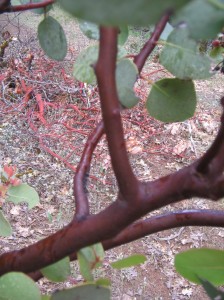 Unlike most trees, which have rough furrowed bark, manzanita bark is very smooth. It’s colors range from orange to almost red or brownish.
Unlike most trees, which have rough furrowed bark, manzanita bark is very smooth. It’s colors range from orange to almost red or brownish.
In late spring and early summer, manzanita, like most woody plants, starts growing a new ring of wood and also a new layer of bark underneath. As the tree expands, the almost paper thin layer of outer bark begins to crack and peel away. This is similar to how a reptile sheds its skin. Except with manzanita, the skin breaks in to small flakes.
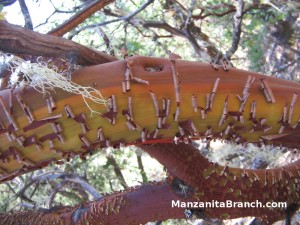
For much of the summer, the old bark curls and slowly sheds. Revealed underneath is a greenish layer of new bark. By the end of summer or fall, this new bark will darken to its usual orange to red color.
Manzanita Leaves
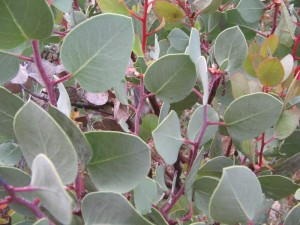 Manzanita has small round to oval leaves, which are around the size of a US quarter, or a little larger. The leaves are evergreen, meaning they stay green all year. The leaves are relatively thick and stiff, and sometimes described as waxy. The leaves are adapted to minimize water loss in the arid climates they often thrive in.
Manzanita has small round to oval leaves, which are around the size of a US quarter, or a little larger. The leaves are evergreen, meaning they stay green all year. The leaves are relatively thick and stiff, and sometimes described as waxy. The leaves are adapted to minimize water loss in the arid climates they often thrive in.
Manzanita Seedlings
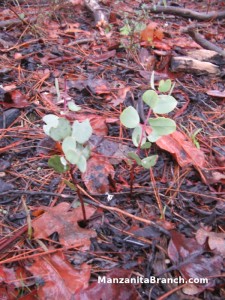 Manzanita seedlings sprout typically after the seeds are disturbed by a soil disturbance, such as fire, and sometimes after the soil is disturbed from clearing, road building, etc. After manzanita is cut away in an area, new seedlings will emerge from the ground.
Manzanita seedlings sprout typically after the seeds are disturbed by a soil disturbance, such as fire, and sometimes after the soil is disturbed from clearing, road building, etc. After manzanita is cut away in an area, new seedlings will emerge from the ground.
Many people believe these are sprouting from the roots of the old trees. But they are actually new trees sprouting from seeds. Manzanita does not sprout back from the stump the way many broadleaf trees do.
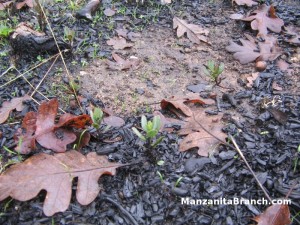
Manzanita seeds can lay dormant in the soil for decades, and it is believed up to a century or more. The heat from fire cracks open the seeds and allows them to germinate. Manzanita can be some of the first plants to emerge and populate an area after a wildfire.
It is a common belief that fire is required in order for manzanita seeds to sprout. But I routinely see seedlings sprouting in areas where there have not been any fires in several decades.
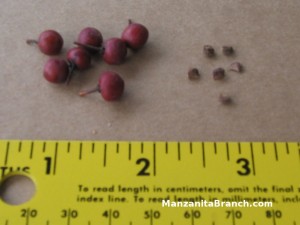
Manzanita seeds ripen in late summer in to the fall. Many fall to the forest floor, but many are eaten by birds, bears, foxes and other wildlife. The seeds pass through the animal’s digestive system unharmed and are deposited in the animal’s scat. This is is one of the most effective ways that manzanita is able to spread it’s seed.
Germinating Manzanita Seeds
Manzanita can be difficult to germinate from seed. The only way I have done it is to do a light burn on the ground where manzanita trees have previously grown. The duff layer on the ground will naturally contain seeds that the parent trees have deposited over the years. By piling a thin layer of dry leaves or slash and lighting it on fire, I have had good results getting manzanita to sprout. You don’t want to put a lot of large woody material in the fire or it will get too hot and burn the seeds up. Although in these cases, I commonly have seedlings sprout around the edge of the fire where it didn’t burn as hot.
If you have the seeds, you could simulate this process by putting the seeds on your planting bed and spreading some pine needles, leaves, paper or other light flammable material on top and burning them. I would then simply leave the seeds alone in the ashes to sprout. Allow them to sit outdoors over winter so they can sprout the next spring.
I have heard of other methods like soaking the seeds in acid to break down the hard shell. Or filing through the shell so moisture can penetrate and activate the seed. But I have no experience with either of these methods.
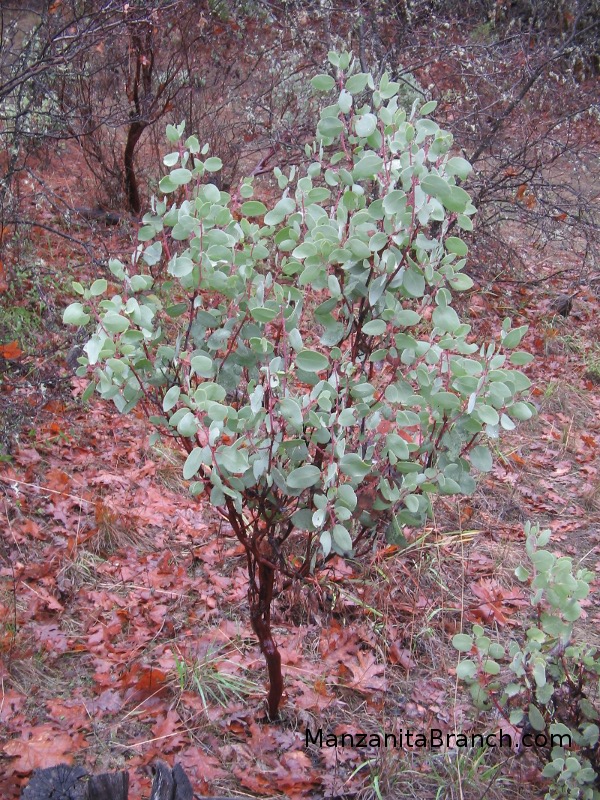
I LIVE IN NO. CALIF. IT GETS VERY HOT HERE 110 TO 115 DEG. IN SUMMER I HAVE A VERY LG MANZANITA TREE THAT IS BEUTIFULL HOWEVER I HAVE NOTICED THAT SINCE THE DROUGHT IT HAS STARTED TO DIE OFF AND THIN OUT AND MANY OTHER TREES IN THE AREA HAVE DIED .CAN THIS BE A LACK OF WATER , FERTILIZER ,DISEASE , OR WHAT ? I DON’T WANT TO LOSE MY TREE WHERE DO I START LOOKING FOR A CAUSE OR A FIX PLEASE HELP ME THANK YOU GARY STANLEY
A friend from north central Arizona, near Sedona, has gifted me with two bare-root Manzanita plants which she harvested from her property. She said these smaller plants were air layered, ie branches of a larger “bush”, perhaps 3 or 4 feet in height or diameter, were able to put down roots where they were in contact with the ground.
I have potted these smaller plants (~1 to 1.5ft above the soil line) in terracotta pots. I’d like to know the cold tolerance of my new Manzanita. I know it gets quite cold where my friend lives, with snow and freezing temperatures. But here in SE Michigan, the USDA zone is ostensibly 6b (or 5a). We can have sub-zero-degF nights, and single digit days, for weeks on end thru Jan & Feb. I am assuming it will be necessary to raise these as “house plants,” taking them outside in the early spring, and bringing them back inside in late fall. I would prefer, however, to grow them in the ground, and shelter them through the winter in some way. (I do this already with fig trees.)
Thanks in advance for your input and advice.
~Allen
Hi Allen,
I don’t have any experience with manzanita in climates that cold. I am in the Northwest in zone 7. Most of our winters see lows in the upper teens and only for a few days per year. It does occasionally get into single digits. Last year it got down to around 3 Degrees F and the manzanita in the wild handles it just fine. How it would do that cold for that long, I don’t know. Also coming from Arizona the genetics may be a little different from a warmer climate than here. Another concern is your wetter humid summers. Manzanita is adapted to hot dry summers and cool damp winters. If it was me I would probably leave one outside and keep one inside and see what happens.
I live in central Arizona, at 5200 feet elevation and our temperatures in the winter can get down into the single digits for up to a month at a time and the manzanita flourishes here.
It’s not true that manzanitas do not root-sprout — at least one species in the coast ranges does. I have about a dozen of these on my property that was burned over in the Valley Fire (2015) and the root-crown sprouting variety have vigorously resprouted!
Yes, there are some that do sprout. I should have specified that this article is about whiteleaf manzanita. This is the variety which is the most widespread variety with commercial applications. Thank you for bringing that oversight to my attention.